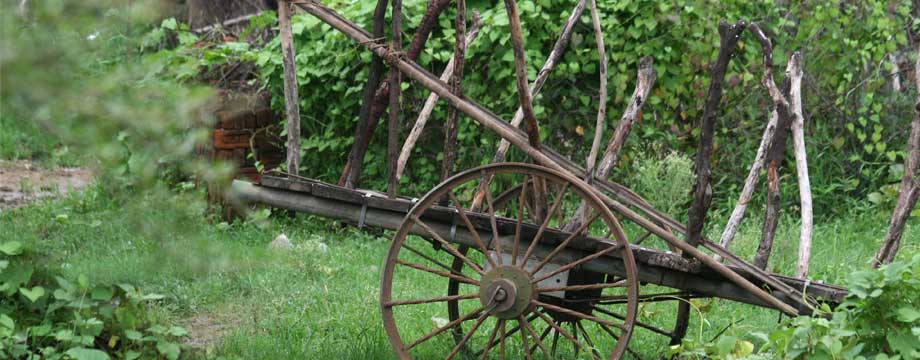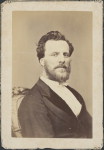Between Brown road in Officer and O’Neil road in Beaconsfield lies a small dirt track called LL road. The name has always intrigued me and try as I might, I have never been able to discover the origin of the name. One theory of mine is that it might have been named after a Dr. L.L. Smith who owned land in the area but not quite adjacent to this road. As quite often happens with these things, my search to discover the origin of the road name led me to another Odd History story, the rather flamboyant and charismatic life of Dr. Louis Lawrence Smith.
Dr. L.L. Smith was born into a theatrical family but did extensive medical training in London and Paris before emigrating to Australia during the gold rush. By 1853 he had a surgery in Bourke street, central Melbourne. None of this is very interesting until you understand that Dr. Smith was not just a medical man but he had a theatrical flair for self promotion. He produced penny pamphlets about himself and had them distributed throughout Melbourne. He also took out extensive newspaper advertisements and it was said that by 1863, he was spending £3000 per year on advertising in newspapers alone. This is at a time when you could purchase a house and land in Brighton for £120. It has been estimated that by 1880, when the average Australian worker’s yearly wage was about £200 he was making £10,000 per year.
Alongside his surgery in Bourke street he opened a one man teaching school and called it a polytech. Next to that he opened a medical/anatomical museum with a number of exhibits and waxwork figures that the public described as immoral and vulgar. He opened a second museum with a partner in Sydney along the same lines and took his exhibition on tour visiting towns like Hobart, Launceston and Adelaide. In a Sydney court case regarding the immorality of the exhibits it was suggested that the main audience were young men who came to see the waxwork figures of naked women. He also gave educational lectures about treatment of many diseases including venereal disease where he managed to offend quite a few of Australia’s genteel society. He ran a very successful mail order doctor service, where for £1 you could describe your symptoms by letter and he would prescribe a cure by return post. He produced and distributed a Medical Almanac full of self promotion and then sold advertising in it. But it was in 1858 that his reputation really took a tumble. He was arrested on a charge of procuring an abortion for a Miss Elizabeth Smith (no relation). He was aquitted of the charge but in 1859 he was called to give evidence at the inquest into the death of an actress, Miss Ellen Mortyn. It was suggested that an abortion was the cause of death but this was too was proven false.
With his reputation in disarray his solution to the problem was an interesting one. He entered politics. By 1859 he won a seat on the State Legislature but again he was in disgrace when he assaulted a fellow MLA, Mr. John Woods. His popularity waxed and waned as he lost seats then was re-elected and by 1872 he was in the spotlight again when he was accused of approaching the commissioner of railways to gain advantage.
About this time he started purchasing land in Dandenong, Nunawading, Narre Warren, Beaconsfield and Upper Beaconsfield. He was very outspoken on his views and he aimed to make his properties “model farms”. His land in Upper Beaconsfield comprised of about 377 acres (about 152 hectares) and was on the Emerald road about where Bimbimbi road is today. This became his country residence and he named it Louisville after himself.
Dr. Charles Wilson and Ann Taylor wrote a wonderful article about Woods street and the Beaconsfield Train Station in 2010. “When the railway line from Sale to Oakleigh was opened in April 1879, there were stations at Berwick and Officer but none at present day Beaconsfield. In 1876, entrepreneur William Brisbane of Berwick, knowing the rail line was being built, and realising there was a great demand for sawn timber and firewood in rapidly expanding Melbourne, entered into partnership with John Day, and built a sawmill near the present day Central Hotel then called the Gippsland Hotel. Brisbane needed a rail siding to get his timber to Melbourne, and knew a siding would also benefit the new selectors in the hills district- now Upper Beaconsfield, and Little Berwick, the small settlement near Cardinia Creek, later named Beaconsfield.
“Brisbane wrote to the Commissioner for Railways several times, requesting a siding at this site, but without success. In a flamboyant gesture, Brisbane invited 120 ladies and gentlemen from Melbourne to lunch at his guesthouse in Upper Beaconsfield on Saturday November 30, 1878.
The guests included three M.L.A’s – Dr. L.L. Smith, Bosisto, and John Woods, all of whom had selected 20 acre blocks in the Upper Beaconsfield area, so would have benefited from the proposed station. The visitors were picked up in horse drawn vehicles at the Berwick Station and on the way to Upper Beaconsfield were shown the place where a station was required.
At lunch, a toast to John Woods the Commissioner for the Railways was proposed. In reply Woods said he accepted Brisbane’s suggestion, and agreed to open a station. He then proposed a toast to Brisbane.”
It appears that this is the same John Woods who Dr. Smith assaulted in 1859. Woods street in Beaconsfield is named after him and I wonder if LL road was so named because of the political rivalry. Interesting that they both took up land in the Beaconsfield area with John Woods on Hughendon road near the corner of Telegraph road and Dr. Smith and a number of his children owning 20 acre blocks in the Dickey and Telegraph road areas.
Our Dr. Smith went on to many other and varied projects. He was heavily involved with the running of the “old” Exhibition Building in Melbourne and as a trustee filled in as chairman while the official was overseas. In typical L.L. Smith fashion he refused to vacate the seat when the official returned. He grew grape vines and was involved in the promotion of Australian wines in Europe. As a memento, the Murray growers presented him with a small gold wine bottle complete with a diamond in place of a cork.
His involvement in the arts was legendary. Actors, singers and producers all called him their friend. He regularly allowed the use of his “polytech” building as a theatre for the arts. He owned an amazing art collection which he regularly loaned out for exhibition. He also had a stable of racehorses and bred bloodhounds. Love him or loathe him, he certainly was one of Australia’s more unusual characters.
Relevant Dr. L.L. Smith Links
- 21 Feb. 1857
- Anatomical Museum and Waxworks Sydney
- Article by Charle Wilson and Ann Taylor
- Biography Dr. L.L. Smith
- Criminal Sessions Trial Elizabeth Smith
- Cyclorama and Exhibitions
- Death of Actress Ellen Mortyn
- House prices brighton 1860
- In the spotlight 1872.
- Involvement in the Exhibition Building
- Marriages and Children
- Museum Tour in Adelaide
- Museum Tour of Launceston
- Obituary
- Polytech Hall in Bourke street
- Sydney Anatomical Museum


